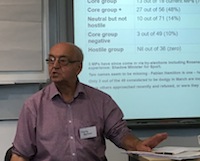FRACKING
Fracking is the process of
drilling down into the earth then moving lengthy
distances horizontally in order to allow a high-pressure mixture of
water, sand and chemicals to be directed at underground layers of rock
in order to release shale gas and/or oil. It involves what are forms
of seismic activity, which are "hoped" to be only very small tremors.
But first of all, those
undertaking the process need to find out if it will be worth their
while. So, initially firms obtain permission from the Government to
undertake investigations. Their searches require them to seek out
appropriate sites to start their underground examinations. They will
then push pipes into the ground, which can eventually be spread out
horizontally in a number of differing directions to test whether they
have found appropriate and commercially viable gas or oil supplies.
INEOS have been given
authority to do this in my own town of Dronfield in the very north of
Derbyshire. They are the largest chemical company in the UK,
operating six plants, the largest being a crude oil
refinery at Grangemouth in Scotland. They are not currently fracking
in the UK, but are importing shale gas and oil from overseas.
Jim Ratcliffe owns 60% of
their shares and is the 30th richest person in the UK at
£3.2 billion – well ahead of Bernie Ecclestone and of the Queen's
personal wealth. A UK fracking programme would place him even higher
up this list.
To set the ball rolling
for stage one of the process (searching for shale gas) a very badly
advertised drop-in meeting was run by the Government's Environment
Agency for the citizens of Dronfield recently. This is so they can
claim (a) that we have been consulted and (b) that we know and are
happy about what is going on.
Once INEOS finds what it
is after and decides it wishes to obtain the shale gas, it will then
apply for a license to the Derbyshire County Council. The Council
have been adopting a “Minerals Local Plan” which will hopefully
be tough enough for them to be able to reject such an application.
Our Constituency Labour Party (based on a Dronfield proposal) have
also sent the County a detailed resolution seeking to block such
applications.
The problem is that even
if the County Council reject INEOS's application, then Jim Radcliffe's
company merely has to go over the County Council's head to the
Government (under a fast track system) to get the blockage to their
application removed.
So we are likely to be
into a sustained political fight against INEOS's plans. At least, the
Labour Party nationally came out against fracking at its recent
Conference – so we can hope for some parliamentary opposition to
the plans.
Why Dronfield ?
Today Dronfield is something of a middle-class, private-car user commuter town, mainly serving Sheffield; with its own Conservative dominated Town Council. So the depth of its working class mining history may come as a surprise to many. It is its mining past which makes it attractive for fracking purposes.
Figures for 1921 showed
that 114 mining operations had taken place over time in Dronfield.
Yet many more bits and pieces have since emerged. A late mine
called Hurst Hollow at the far end of Dronfield Woodhouse, being
closed in 1947. Nearly 70 years ago.
Coal getting operations
started around the 16th Century – initially these were
just surface pickings and shallow ditches at places such as Stubley Hollow and
Hill Top .
Then up to the 18th
Century came outcrops, adit mines (i.e tunnels into hillsides),
bell pits where people dug a shaft into the ground and took out coal
without supports in a circular fashion and then moved further down the
coal seam to dig a fresh bell shaped pit. For instance, a map of Firth
Wood indicates a row of 24 bell pits along a coal seam. Evidence of
former bell pits were also revealed during the building of the
Unstone-Dronfield By-pass. Holmley Lane and many other areas are also
likely to have had bell pits.
There were also some 40 pits as
either drift mines or with shafts in the Dronfield and Unstone areas
by the second half of the 19th century. Their development
being aided by (a) the establishment of the Lucas Iron Malleable
Foundry in 1811, (b) railway development in 1870 when Dronfield
Railway Station was opened and (c) the shortly lived Wilson Cammell
Steel Plant on Callywhite Lane from 1873 to around 1883. It is
claimed that by 1879 the neighbouring Dronfield Silkstone Pit was
then the town's largest employer.
In the late 19th
Century pits were also entitled Dronfield Woodhouse, Gomersal, Green
Lane, Hill Top, Longcroft, Gosforth, Stubley Hollow. The Coal Aston area of Dronfield also
takes its name from coal mining. Then there were also many pits in
neighbouring areas such as Apperknowle, Mickley and a wide range in
Unstone.
In other words, the
Dronfield area has over time been pocked marked with pits and mining
operations and is today covered with existing and worked out coal
seams. Any building, garden, road, railway line or street is likely to be close to former coal mining operations.
Shale gas and oil are
likely to be found significantly in these types of area, leading to the
clear danger of us being subject to major, dangerous, and long term
fracking operations in our community.
In North Derbyshire, Dronfield is by no means alone in facing fracking dangers. It is united in this situation with many former mining communities whose pits were still functioning in the final decades of the 20th Century. We are by no means isolated in our struggle against fracking proposals. We need to appreciate that there is strength in unity.
(Details of Dronfield's mining history can be found in articles in "Dronfield Miscellany" by writers including Kathy Kearn and James Cartwright).
